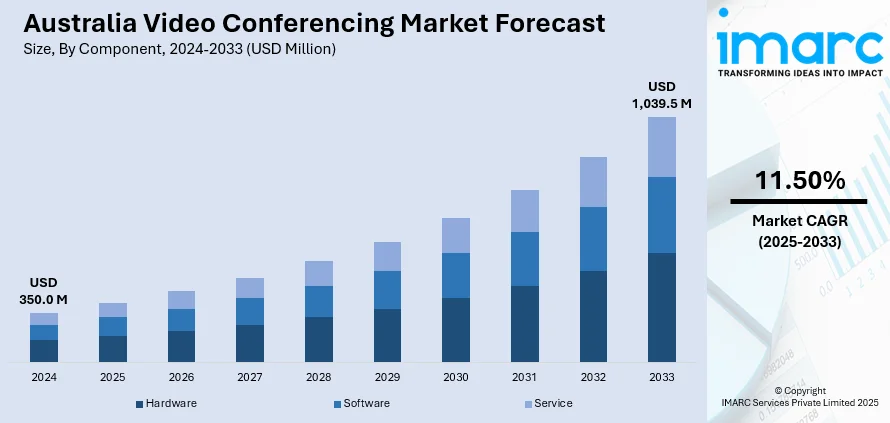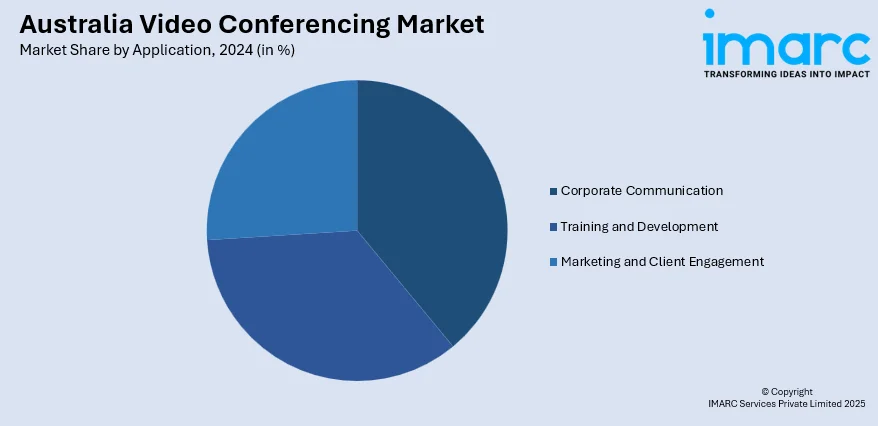
Australia Video Conferencing Market Size, Share, Trends and Forecast by Component, Conference Type, Deployment Mode, Enterprise Size, Application, End-Use, and Region, 2025-2033
Australia Video Conferencing Market Overview:
The Australia video conferencing market size reached USD 350.0 Million in 2024. Looking forward, IMARC Group expects the market to reach USD 1,039.5 Million by 2033, exhibiting a growth rate (CAGR) of 11.50% during 2025-2033. Factors driving the market include the rising adoption of remote and hybrid work models, the need for reduced travel costs, advancements in internet infrastructure and mobile technologies.
|
Report Attribute
|
Key Statistics
|
|---|---|
|
Base Year
|
2024
|
|
Forecast Years
|
2025-2033
|
|
Historical Years
|
2019-2024
|
| Market Size in 2024 | USD 350.0 Million |
| Market Forecast in 2033 | USD 1,039.5 Million |
| Market Growth Rate 2025-2033 | 11.50% |
Australia Video Conferencing Market Trends:
Integration of Artificial Intelligence
The Australian video conferencing market is seeing increasing artificial intelligence (AI) integration to enhance meeting capabilities as well as overall productivity. AI-enabling capabilities like smart noise cancellation, automated meeting transcription and summaries, and virtual scheduling assistants and task management are being increasingly demanded. Such functionalities seek to organize meeting processes more efficiently, enhance knowledge retention, and automate procedural activities, allowing for the free release of time by participants for substance-driven discourse and decision-making. The application of AI analytics for offering meeting participation and productivity insights is a nascent development that helps companies better plan virtual collaboration and induce improved online experiences. For instance, in 2025, with a special focus on virtual communication, EQUANS launched EQUANS Digital across Australia and New Zealand. This new division integrates a vast network of 6000 ICT experts, offering specialized capabilities in audiovisual and video conferencing solutions. Alongside broader digital transformation services, EQUANS Digital leverages data insights and AI to deliver cost-effective and tailored video conferencing experiences, supported by their national and local digital centers.

To get more information on this market, Request Sample
Proliferation of Cloud-Based and Hybrid Deployment Models
One major trend influencing the Australian video conferencing market is the growing demand for cloud-based and hybrid deployment models. Cloud solutions are flexible, cost-effective, and scalable, enabling organizations to flex their video conferencing infrastructure according to variable demands without major upfront hardware investment. Furthermore, the ease of deployment and management associated with cloud platforms is a key driver for their widespread adoption. Hybrid models, which combine on-premises infrastructure with cloud-based services, are also gaining traction, particularly among organizations with stringent data security requirements or existing infrastructure investments. This blended approach allows for a tailored solution that balances security, control, and the benefits of cloud-based flexibility. For instance, in April 2024, Zoom Video Communications announced the general availability of Zoom Workplace, its AI-powered collaboration platform. This platform integrated novel features across Meetings, Team Chat, and Spaces with the objective of enhancing teamwork and productivity. The AI Companion, provided without additional cost, offered multi-language chat summarization and message composition functionalities. Noteworthy additions included a streamlined meeting tab interface, customizable application themes, a multi-speaker view, document co-editing capabilities, and personalized audio isolation. Furthermore, Team Chat incorporated tabs, an enhanced search function, and AI-powered quick scheduling.
Australia Video Conferencing Market Segmentation:
IMARC Group provides an analysis of the key trends in each segment of the market, along with forecasts at the region/country level for 2025-2033. Our report has categorized the market based on component, conference type, deployment mode, enterprise size, application, and end-use.
Component Insights:
- Hardware
- Camera
- Microphone/Headphone
- Others
- Software
- Service
- Professional Services
- Managed Services
The report has provided a detailed breakup and analysis of the market based on the component. This includes hardware (camera, microphone/headphone, and others), software, and service (professional services and managed services).
Conference Type Insights:
- Telepresence System
- Integrated System
- Desktop System
- Service-Based System
The report has provided a detailed breakup and analysis of the market based on the conference type. This includes telepresence system, integrated system, desktop system, and service-based system.
Deployment Mode Insights:
- On-Premises
- Cloud-Based
The report has provided a detailed breakup and analysis of the market based on the deployment mode. This includes on-premises and cloud-based.
Enterprise Size Insights:
- Large Enterprises
- SME (Small and Medium-sized Enterprises)
The report has provided a detailed breakup and analysis of the market based on the enterprise size. This includes large enterprises and SME (small and medium-sized enterprises).
Application Insights:

- Corporate Communication
- Training and Development
- Marketing and Client Engagement
The report has provided a detailed breakup and analysis of the market based on the application. This includes corporate communication, training and development, and marketing and client engagement.
End-Use Insights:
- Corporate
- Education
- Healthcare
- Government and Defense
- BFSI
- Media and Entertainment
- Others
The report has provided a detailed breakup and analysis of the market based on the end-use. This includes corporate, education, healthcare, government and defense, BFSI, media and entertainment, and others.
Regional Insights:
- Australia Capital Territory & New South Wales
- Victoria & Tasmania
- Queensland
- Northern Territory & Southern Australia
- Western Australia
The report has also provided a comprehensive analysis of all the major regional markets, which include Australia Capital Territory & New South Wales, Victoria & Tasmania, Queensland, Northern Territory & Southern Australia, and Western Australia.
Competitive Landscape:
The market research report has also provided a comprehensive analysis of the competitive landscape. Competitive analysis such as market structure, key player positioning, top winning strategies, competitive dashboard, and company evaluation quadrant has been covered in the report. Also, detailed profiles of all major companies have been provided.
Australia Video Conferencing Market News:
- In March 2025, FUJIFILM Business Innovation Australia (formerly Fuji Xerox) strategically transformed to meet modern business needs beyond document solutions. Rebranding sub-brands to FUJIFILM IT Services and Process Automation, they integrated past acquisitions to strengthen digital capabilities across the Fujifilm Group in Australia. Driven by client needs, they now offer consulting, managed IT, process automation, communication solutions, and video conferencing services and related products as part of their broader unified communications and IT solutions. aiming to simplify operations and future-proof businesses.
- In April 2024, Adobe introduced Frame.io V4, a new generation of its creative collaboration platform designed to accelerate content workflows. Key features include a dynamic metadata framework, smart folders called Collections, and a redesigned review and approval system. Frame.io V4 aims to streamline feedback, reduce revisions, and speed up media asset delivery for creative teams and enterprises.
- In March 2024, Cisco expanded its strategic partnership with BBVA, a global financial services group, through a Whole Portfolio Agreement (WPA). This agreement provides BBVA with faster access to Cisco's software and Customer Experience (CX) portfolio, covering cybersecurity, collaboration, data center, networking, and services across multiple countries. The five-year deal streamlines BBVA's IT operations by consolidating 3,000 contracts into one, improving efficiency and enabling access to future Cisco technological developments, including AI-driven innovations.
Australia Video Conferencing Market Report Coverage:
| Report Features | Details |
|---|---|
| Base Year of the Analysis | 2024 |
| Historical Period | 2019-2024 |
| Forecast Period | 2025-2033 |
| Units | Million USD |
| Scope of the Report |
Exploration of Historical Trends and Market Outlook, Industry Catalysts and Challenges, Segment-Wise Historical and Future Market Assessment:
|
| Components Covered |
|
| Conference Types Covered | Telepresence System, Integrated System, Desktop System, Service-Based System |
| Deployment Modes Covered | On-Premises, Cloud-Based |
| Enterprise Sizes Covered | Large Enterprises, SME (Small and Medium-Sized Enterprises) |
| Applications Covered | Corporate Communication, Training and Development, Marketing and Client Engagement |
| End-Uses Covered | Corporate, Education, Healthcare, Government and Defense, BFSI, Media and Entertainment, Others |
| Regions Covered | Australia Capital Territory & New South Wales, Victoria & Tasmania, Queensland, Northern Territory & Southern Australia, Western Australia |
| Customization Scope | 10% Free Customization |
| Post-Sale Analyst Support | 10-12 Weeks |
| Delivery Format | PDF and Excel through Email (We can also provide the editable version of the report in PPT/Word format on special request) |
Key Questions Answered in This Report:
- How has the Australia video conferencing market performed so far and how will it perform in the coming years?
- What is the breakup of the Australia video conferencing market on the basis of component?
- What is the breakup of the Australia video conferencing market on the basis of conference type?
- What is the breakup of the Australia video conferencing market on the basis of deployment mode?
- What is the breakup of the australia video conferencing market on the basis of enterprise size?
- What is the breakup of the Australia video conferencing market on the basis of application?
- What is the breakup of the Australia video conferencing market on the basis of end-use?
- What is the breakup of the Australia video conferencing market on the basis of region?
- What are the various stages in the value chain of the Australia video conferencing market?
- What are the key driving factors and challenges in the Australia video conferencing market?
- What is the structure of the Australia video conferencing market and who are the key players?
- What is the degree of competition in the Australia video conferencing market?
Key Benefits for Stakeholders:
- IMARC’s industry report offers a comprehensive quantitative analysis of various market segments, historical and current market trends, market forecasts, and dynamics of the Australia video conferencing market from 2019-2033.
- The research report provides the latest information on the market drivers, challenges, and opportunities in the Australia video conferencing market.
- Porter's five forces analysis assist stakeholders in assessing the impact of new entrants, competitive rivalry, supplier power, buyer power, and the threat of substitution. It helps stakeholders to analyze the level of competition within the Australia video conferencing industry and its attractiveness.
- Competitive landscape allows stakeholders to understand their competitive environment and provides an insight into the current positions of key players in the market.
Need more help?
- Speak to our experienced analysts for insights on the current market scenarios.
- Include additional segments and countries to customize the report as per your requirement.
- Gain an unparalleled competitive advantage in your domain by understanding how to utilize the report and positively impacting your operations and revenue.
- For further assistance, please connect with our analysts.
 Request Customization
Request Customization
 Speak to an Analyst
Speak to an Analyst
 Request Brochure
Request Brochure
 Inquire Before Buying
Inquire Before Buying




.webp)




.webp)












